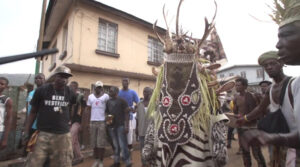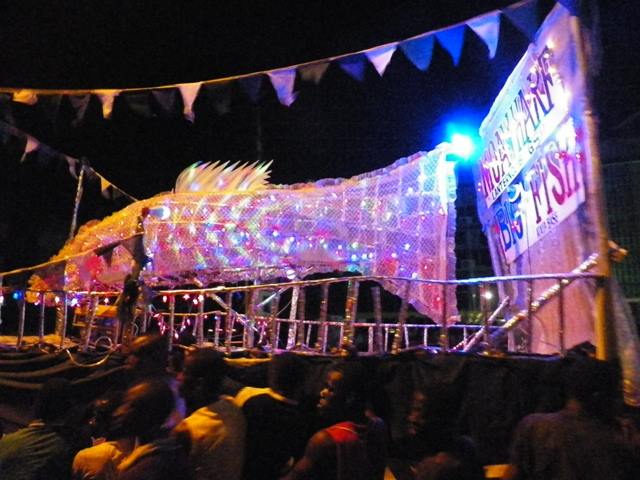Sierra Leoneans at home and abroad have called on President Julius Maada Bio to ensure that before he leaves power in 2028 that the people and our foreign friends are once again given the pleasure of witnessing the popular lantern and paddle parades and the joy and pride associated with the celebration of the nation’s Independence Day.
Citizens that responded to questions posed by Nightwatch on the issue of theses cultural celebrations not factoring on the calendar of events on the ruling party’s agenda have said the people of Sierra Leone work hard but don’t have national events to celebrate as a means of unwinding, adding that “all work and no play is making us (Sierra Leoneans) dull.”
For the past six years since president Maada Bio took over as president, the popular cultural events of paddle and lantern have been missing from our national calendar of events with speculations by the regime that they could be used to foment social unrest, to demonstrate and to overthrow his regime.
Apart from encouraging the promotion of our culture, the history of the lantern and paddle parades and our Independence Day celebrations are tourist attraction events as many of our people in the diaspora and others flood to Freetown to celebrate these events. If we were a serious people and government such events would have been elevated to must attend events by cultural tourists from around the world. According to Ahmed Tejan Cole of the Heritage Foundation the lantern parade has a long-standing history as an integral part of Sierra Leone’s cultural heritage, dating back to its introduction in Freetown in the 1930s. However, the origins of the parade are still a subject of debate. According to John W. Nunley in his article “The Lantern Festival in Sierra Leone,” Sierra Leonean trader Daddy Maggay introduced the parade after being inspired by a similar display he witnessed in Banjul, then Bathurst, The Gambia. Maggay’s account claimed that the Catholic fathers in Bathurst paraded with hand-held lighted objects during Easter and Ramadan.
However, there are incongruities in this story that remain unexplained, and another school of thought traces the origins of the lantern parade to the traditional Ramadan lantern, or fanous, which has its roots in ancient Egypt. The fanous was used during annual festivals to celebrate the birth of prominent deities in the pharaonic pantheon, such as Osiris, Horus, Isis, Seth, and Nephthys. Today, the fanous is a common sight in most Muslim-majority countries, and it has become a symbol of the magic of Ramadan. In Egypt, the fanous has become an essential part of Ramadan celebrations and has spread to other Arab countries as well, although it has no intrinsic link to religious rituals. The fanous has become a symbol of joy and a beloved tradition during Ramadan.
In the 1930s, Freetown lanterns were said to be simple hand-carried objects to large floats with bamboo platforms, wire images, and bamboo substructures covered with layers of fine fabric and paper. However, this evolved. In the 1950s, the Odelay societies began building lanterns, and the competition among groups reached its peak. New groups with names like Beetles, Ashanti, and Combo Super Stars reflected the urban style consciousness of the youth who had taken charge of the festival. The original bubu groups disbanded, as its members were too old to participate in the rigorous aesthetic competitions.

To organise the festival further and reduce violence, the Young Men’s Muslim Association (YMMA) took control of the parade and organised the entries by iconographical type. They grouped the entries into ships, animals and people, and miscellaneous subjects, covering secular themes such as amusement parks with merry-go-rounds and Ferris wheels. The YMMA raised funds for the festival and distributed them among the qualified entrants, bringing about a new age in lantern-building competition.
In the 1970s, with increasing commercialisation, the lanterns became bigger and better and the floats had to be pulled by teams of men or motor vehicles. The leading business houses became the patrons of the lanterns. However, the commercialisation of the parade also saw a rise in crime and violence associated with it, leading to tighter government regulations.
Nonetheless, the parade continued to grow in size and incorporate professional musicians. It spread from the Fourah Bay community in the east end of Freetown to the central part of the city. Various groups, such as the Obasai Ojeh, were formed to build lanterns. Names like Abou Whyte, Eustace Yaskey, Abdul Tee Jay and Deen Gabisi became synonymous with lantern parades.
Eventually, the outbreak of the civil war resulted in the suspension of the lantern parade. However, a group of individuals interested in preserving the cultural heritage of our country came together and formed a private company called Heritage Foundation and restarted the parade in 2004. The decision was taken to move the parade to the eve of our independence partly to secularise the event and broaden its national appeal, making it inclusive for people from different communities and religions. However, since he took power the government of president Bio has not allowed for lantern parade alleging that it would lead to civil unrest.
The parade’s influence has expanded beyond Freetown to other parts of Sierra Leone. In Mange Bureh and Mambolo, the Themne have a long-standing tradition known as “a-wuthpa,” (oothpa) which involves all-night dancing and singing in the streets at the end of Ramadan. They adopted Muslim customs to fit in with their traditions of dance and song, the custom of a-wuthpa having become more of a traditional dance festival involving Themne songs and performances. This cultural fusion has added a unique flavour to the Lantern Parade in Sierra Leone, showcasing the diversity and richness of the country’s cultural heritage.
Despite the parade’s popularity, it has faced several challenges over the years. Ethnic and leadership conflicts among groups have led to violence during some of the early lantern parades. Opposition from the elders of the Aku community at Fourah Bay, who were concerned about the link between the celebrations and Laylat al-Qadr, led to the parade being moved to the 30th day of Ramadan to accommodate those who wanted to observe the holy month in peace.
In addition, the politicisation of the parade in the 1960s, with political parties sponsoring lanterns for their interests, and the commercialisation of the parade in the 1970s with sponsorship from businesses led to tighter regulations. The parade was also inspected at the police station to prevent inflammatory songs and ensure the lanterns were safe.
When it was last held, the Lantern Parade was a highly anticipated event in Sierra Leone, drawing thousands of participants and spectators from all walks of life. The parade was a vibrant display of creativity, artistry, and community spirit, with lanterns crafted in various shapes, sizes, and themes. Participants spend weeks, sometimes even months, designing and building their lanterns using a wide range of materials such as bamboo, wire, fabric, paper, and colourful lights.
The Lantern Parade is not only a celebration of Sierra Leonean culture and tradition but also a platform for social and economic empowerment. The competition aspect of the parade encourages healthy competition among participants, promoting skill development and innovation. Additionally, the parade provides opportunities for local artisans, musicians, and businesses to showcase their talents and products, generating economic activity and promoting tourism in the country.
The significance of the Lantern Parade goes beyond its cultural and economic impact. It symbolises unity and harmony, bringing people from different communities, religions, and backgrounds together in a spirit of celebration and joy. It promotes social cohesion and fosters a sense of belonging among Sierra Leoneans, reinforcing the country’s cultural identity and national pride.
Bringing back the Lantern Parade in Sierra Leone would be a significant step in reviving and celebrating our cultural heritage. It would manifest the quintessential fun-loving spirit of Sierra Leoneans at its best, showcasing our creativity, craftsmanship, and community spirit. The lantern parade has the potential to be a major tourist attraction, drawing visitors from around the world to experience the magic, excitement, and unique cultural heritage of Sierra Leone. Similar to other famous carnivals and parades around the world, such as Mardi Gras, Notting Hill Carnival, Rose Parade in Pasadena, California, and Rio Carnival, the lantern parade has the potential to showcase Sierra Leone’s rich cultural heritage and boost tourism.
Moreover, reviving the lantern parade can have positive economic impacts. It can generate revenue through business sponsorship and attract tourists, creating opportunities for local artisans, musicians, and other stakeholders. The parade can also promote cultural exchange, as people from different communities and religions come together to celebrate in a spirit of unity and diversity. The organisers can work with the National Tourist Board and other stakeholders to regulate the parade, ensuring that participants adhere to safety standards and promoting the use of sustainable materials in lantern construction. Efforts should be made to ensure the parade gains international recognition and include it in UNESCO’s list of Intangible Cultural Heritage.
It is time to bring back the lantern parade, paddle and our Independence Day celebrations in Sierra Leone. They have been banned for too long. With careful planning, organisation, and adherence to regulations, the lantern parade and other cultural heritage celebrations can be revived in a way that illuminates the nation’s rich cultural tapestry and serves as a symbol of unity and celebration for generations to come.
Meanwhile, according to vikidia, paddle is an enchanting masquerade deeply ingrained in Sierra Leonean culture, stands as a poignant symbol of it nation’s heritage. Rooted in the traditions of the Mende and Themne ethnic groups, Paddle has evolved into a national treasure, attracting Sierra Leoneans worldwide to witness its captivating performances. This article delves into the historical origins, ritualistic significance, global celebration, and the diverse styles of Paddle masquerades.
Paddle’s inception can be traced to the Mende and Themne communities, where it served as a conduit for storytelling and cultural expression. Historically, this masquerade acted as a medium for conveying moral lessons, community values, and narratives that mirror Sierra Leone’s diverse ethnic landscape. Paddle is characterised by elaborate costumes, masks, and rhythmic dances, creating an immersive experience deeply interwoven into the cultural fabric of the nation.
The ritualistic importance of Paddle extends to its role in significant cultural events and rites of passage. Serving as a spiritual bridge connecting the physical world with ancestral spirits and deities, Paddle is frequently performed during ceremonies that mark life transitions. The symbolic narratives enacted by participants, adorned in intricate costumes and masks, serve to reflect the spiritual connection and cultural identity of the community. Paddle’s influence transcends Sierra Leone’s borders, beckoning Sierra Leoneans residing abroad to return home for the occasion. Many members of the diaspora organise Paddle celebrations in foreign countries, replicating the unique Sierra Leonean style. This global celebration not only fosters a sense of unity among the diaspora but also introduces Paddle to diverse audiences, promoting cross-cultural understanding.
A notable feature of Paddle is its adaptability and diversity in styles and costumes. Communities and individuals often tailor the masquerade to fit local traditions and personal preferences. Paddle can be constructed using a variety of materials, showcasing the creativity and uniqueness of each performance. This dynamic nature ensures that Paddle remains a living tradition, evolving with the times while preserving its cultural essence.
Therefore before leaving State House it is our hope that president Bio and his ruling SLPP as a parting gift would allow for us to put down our work kits and dress up and parade to unwind from our arduous labours.


